As part of the celebration of the 70th anniversary of Topps baseball cards, we've asked fans (as well as our staff) to submit their all-time favorite baseball cards, and we've broken them down by team. We'll be revealing submissions regularly throughout the season, ranging from the famous to the weird, and everything in between.
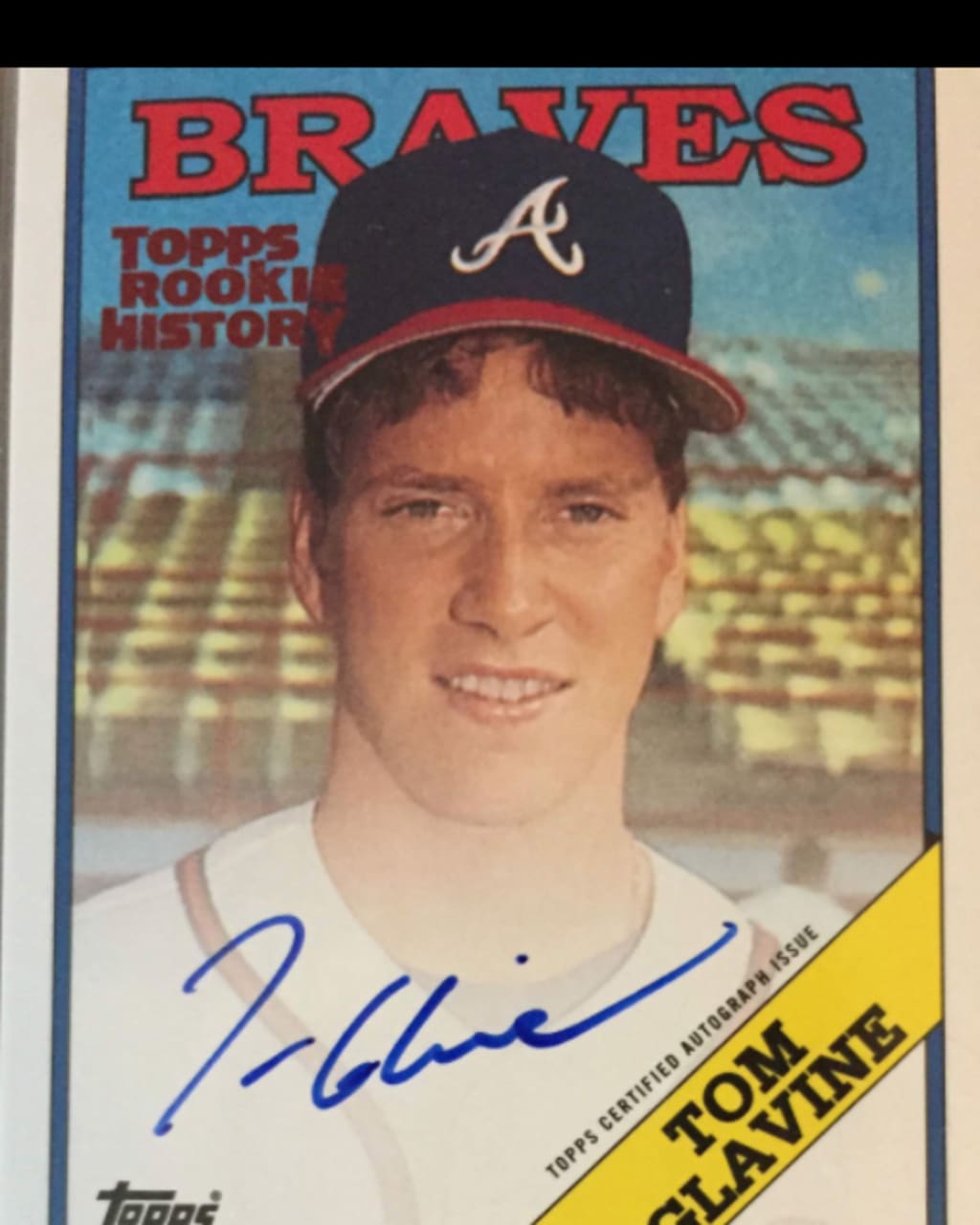
Tom Glavine, 2018 Topps Archives -- Rookie History
It’s awesome that Topps has done remakes of classic cards in its history with Topps Archives, including the 1988 set, which includes this gem that was submitted in our survey by Xander M. of Canastota, N.Y.
Glavine made his MLB debut on Aug. 17, 1987, and this card captures the image of a rookie with a Hall of Fame career ahead of him. Little did the left-hander know it then, but he would become one of the three pillars of the decade’s greatest starting rotation along with Greg Maddux and John Smoltz.
Glavine was the MVP of the 1995 World Series, in which he posted a 1.29 ERA in two starts, including an eight-inning masterpiece against the Indians in the Series-clinching Game 6. He was a two-time National League Cy Young Award winner and a 10-time All-Star.
He was instrumental in the great turnaround of the Braves franchise, which won 14 consecutive division championships from 1991-2005. But before all of that, Glavine was a 21-year-old rookie on a team that finished in fifth place in the NL West. -- Manny Randhawa

Billy Wagner, 2010 Topps Update
Wagner had a lengthy run as a top closer for the Astros, Phillies and Mets, but after undergoing Tommy John surgery at the age of 37 in ‘08, the left-hander seemed to be nearing the end.
However, after returning to the Mets for two appearances in August ‘09, Wagner was traded to the Red Sox and showed he still had something left in the tank, recording a 1.98 ERA with 22 K’s in 13 2/3 innings down the stretch.
Wagner signed with the Braves as a free agent during the offseason and went on to have an All-Star season, posting a 1.43 ERA with 37 saves and 104 strikeouts in 69 1/3 innings. Despite that success, Wagner opted to hang up his cleats after the season, and his Braves tenure is now a distant memory, although it lives on via this '10 Topps Update card. -- Thomas Harrigan
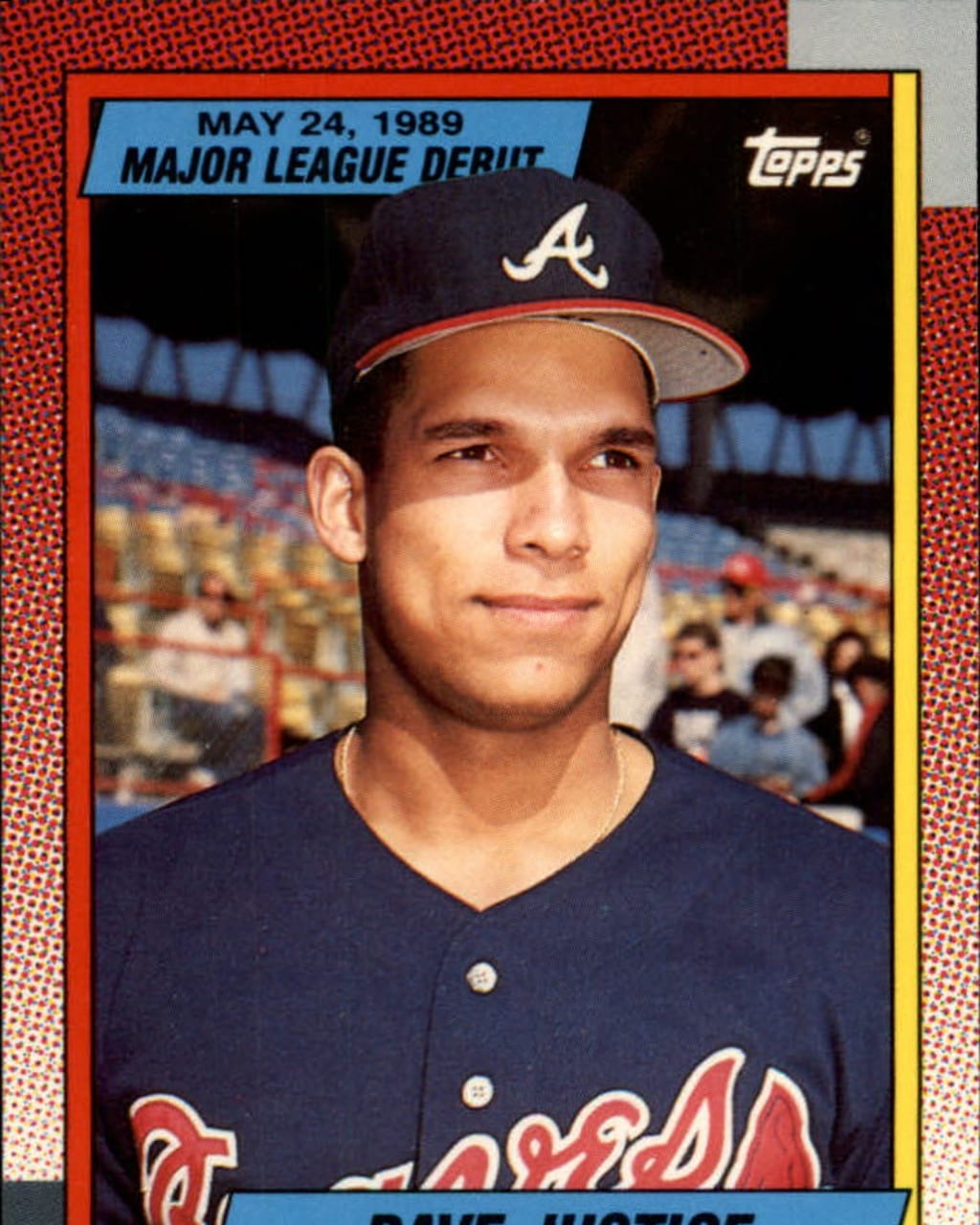
David Justice, 1990 Topps
Justice will forever be remembered as a key component of the Braves’ great success in the 1990s, which included a World Series title in 1995. It was in the clinching Game 6 of that Fall Classic against Cleveland that he provided the only offense of the game, a solo home run to back a gem from Tom Glavine that brought Atlanta its first World Series championship.
This card depicts the beginning of Justice’s run, as well as that of the Braves -- it was the year after this card was printed that Justice helped Atlanta reach the World Series after the club had finished no higher than fifth place in the National League East in each of the previous six years.
The 1990 Topps set was simple but bold, and included debut dates for their rookie cards -- as can be seen here, Justice’s debut came on May 24, 1989, when he went 1-for-5 in a 14-inning loss to the Pirates at Atlanta-Fulton County Stadium. -- Manny Randhawa
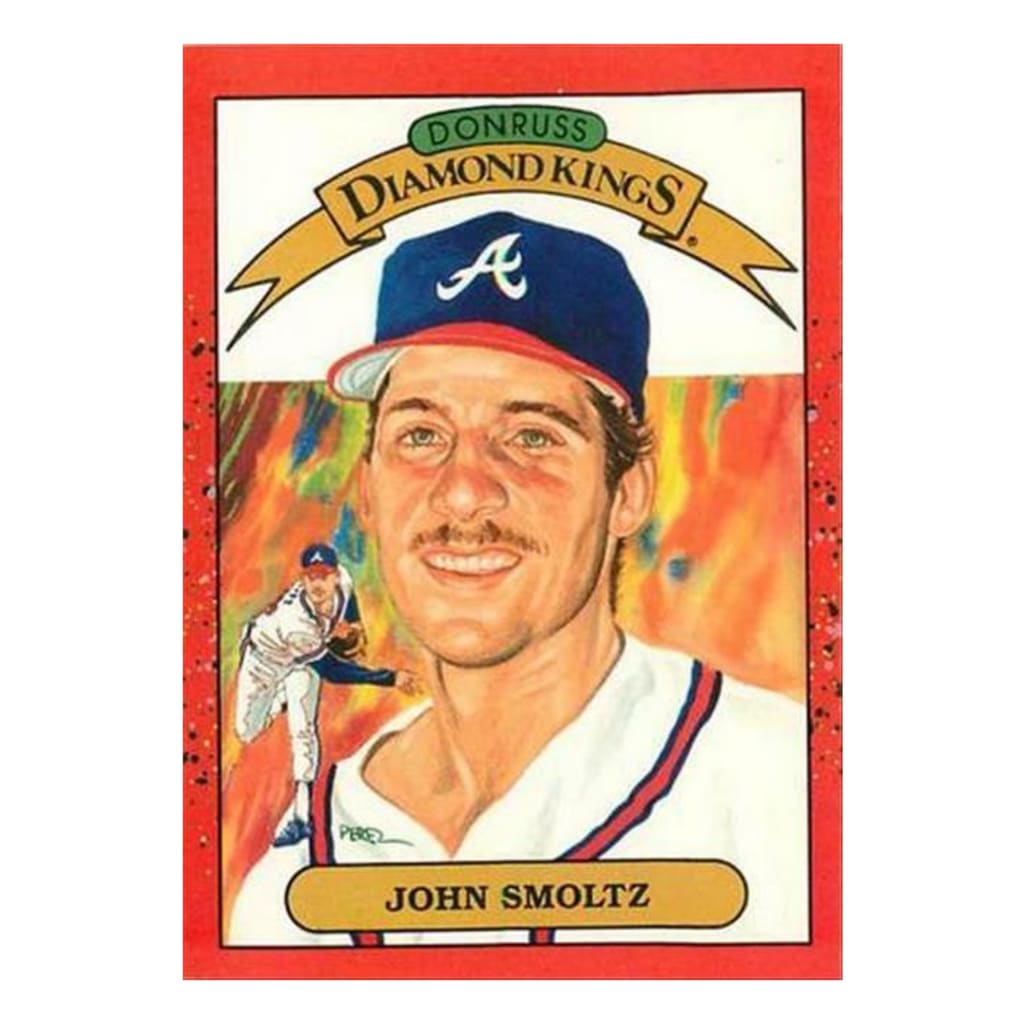
Best Braves facial hair card: John Smoltz, 1990 Donruss Diamond Kings
Donruss' Diamond Kings portrait-style cards are always some of the best-looking cards around. This one of a young, mustachioed John Smoltz is no different.
In 1990, Smoltz was 23 years old and coming off his first career All-Star season. In Atlanta, he would become a part of the iconic Big Three starting-pitching trio alongside Greg Maddux and Tom Glavine.
But here, on this card, Smoltz was still in the very early stages of the Hall of Fame career that included the 1996 NL Cy Young Award and a World Series championship in 1995.
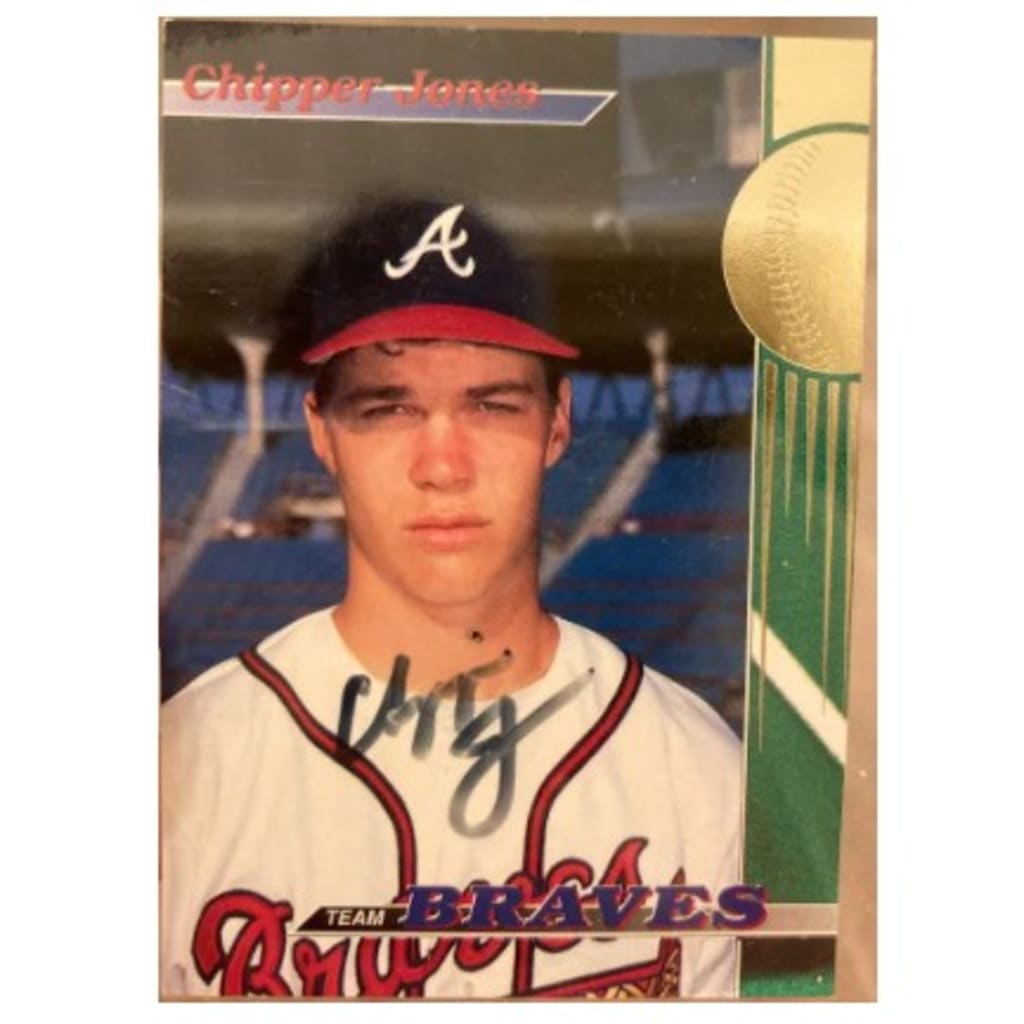
Chipper Jones, 1993 Topps Stadium Club
A September callup in '93, Chipper Jones had yet to make his Major League debut when this card was printed. It's not especially notable in the collecting sphere, as the future Hall of Famer started appearing in baseball card sets as early as '91, but Nate E. of Idaho Falls, Idaho, wrote in to share why the card means more to him than any other.
"I was a radiation therapist for a patient named Don, and a special bond was created between us when we realized we were both Atlanta Braves fans. Unfortunately, I found out a few months later that Don had passed away. A few weeks later, I got a surprise visit at work from his wife. She had a signed Chipper card in her hand and explained a touching story about how they had been going through his prized possessions before he passed. They came across that card, and he immediately said, 'There’s only one person I know who will appreciate this as much as I do!'
"Needless to say, I don’t think I will ever own a card as special as this one." -- Thomas Harrigan
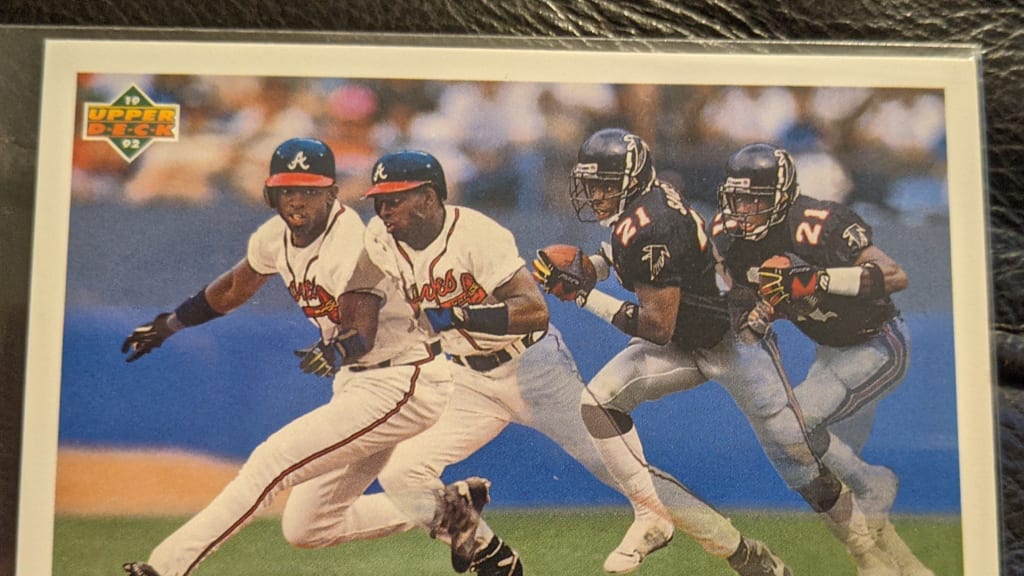
Deion Sanders, 1992 Upper Deck
Wow. Look at this beauty. They don’t get much more creative than this -- a card featuring “Prime Time” in his element -- morphing from a defensive back for the Atlanta Falcons into a center fielder for the Braves as he takes his lead from first base.
The simplicity of this card is also a great feature -- there are no words except for the Upper Deck logo in the top-left corner of the card, which is in landscape mode. After all, no words are really needed when the art speaks volumes.
Patrick L. of Wake Forest, N.C., submitted this card and sums it up well:
“1992 Upper Deck Deion Sanders "Prime Times Two" -- I got this card out of a pack as a kid and it was one of the coolest cards (and still is) that I've ever owned.”
It’s one of the coolest cards, period. And it truly captures what Deion Sanders accomplished as a two-sport star. Sanders stole 186 bases over 641 MLB games while also enjoying a 14-year Hall of Fame career in the NFL. He is the only athlete to ever play in both the World Series and the Super Bowl.
You’d be hard-pressed to find a card more reflective of Sanders’ unique talents than this one from the 1992 Upper Deck set. -- Manny Randhawa
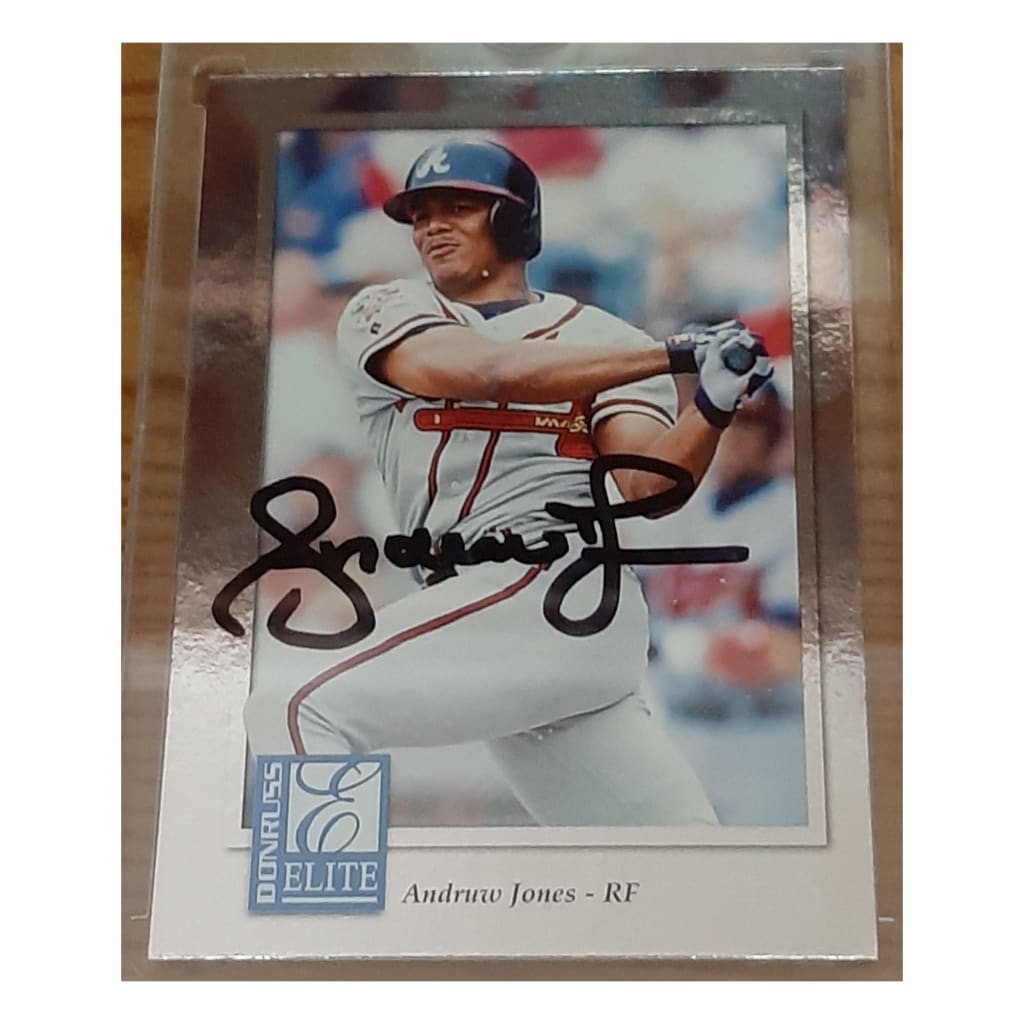
Andruw Jones, 1998 Donruss Elite
In the '98 Donruss Elite card of Andruw Jones, you can see the Braves slugger's power. Jones' body is twisted toward the camera, his face straining as he follows through on his swing.
That swing produced 368 home runs over 12 seasons in a Braves uniform, but if you flip this card over and look at the back, you'll see only two seasons and 23 of those homers listed. Jones was just 21 years old entering the 1998 season. He'd just finished fifth in the NL Rookie of the Year voting, but he had 10 Gold Glove Awards, a Silver Slugger Award and five All-Star seasons ahead of him.
The caption under Jones' statistics reads, "Andruw gave the Braves power, speed and strong defense as a '97 rookie. He has a powerful arm." How true those words proved to be.
For Todd Oxendine of Sumter, S.C., this card is extra special -- and it has Jones' signature on it: "He was my favorite player growing up. I got a chance to meet Andruw a few years ago in Myrtle Beach, S.C., at a Pelicans game during Braves weekend. I was like a kid in a candy store. He signed my card and a baseball and talked with me for a few minutes. One of the nicest players I've met."
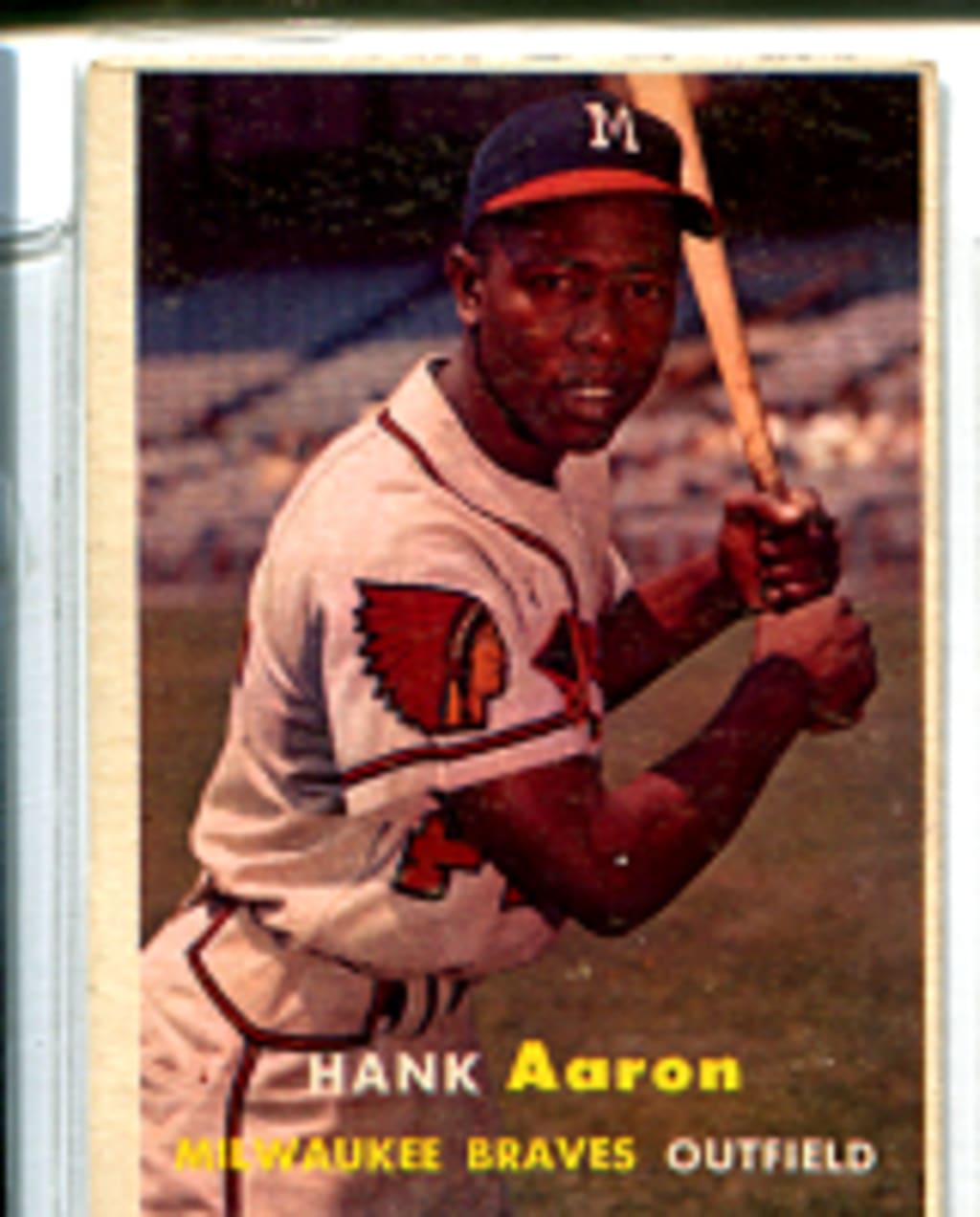
Hank Aaron, 1957 Topps
Hank Aaron is the iconic Brave, and indeed, one of the most iconic figures in baseball history. The number 755 is etched in every baseball fan's mind as iconic in the game's history. That's how many home runs Hammerin' Hank hit over his legendary 23-season career. But the Aaron we see in this beautiful card is of a 23-year-old rising star who had 689 home runs still ahead of him.
The 1957 Topps set is simple and clean, with a white border and white lettering except for the player's last name and team, which are printed in yellow. What's weird is that Aaron's image was printed backwards, making him look like a left-handed hitter. Aaron, of course, hit from the right side. How can you tell that he isn't just holding the bat as if he was a lefty for the photo shoot? Check out the number on the front of his jersey, just below his arm -- Aaron wore No. 44, and you can see that there's a backwards 4 there. Sure, Aaron hit cross-handed when he was younger, but this is a step or two further than cross-handed.
Another great element to this card is that it's from 1957, the only year the Milwaukee Braves won the World Series, and the only time Aaron won it all -- though he helped lead the club back in a rematch against the Yankees the following year.
How did Aaron do in 1957, you ask? Well, the future home run king fittingly led the Majors with 44 homers (somehow, the only time in his career he led the Majors in homers; he did lead the National League three other times). He also led all of baseball in RBIs (132) and total bases (369), while leading the NL with 118 runs scored.
There have been a lot of Aaron cards over the years, but this one is a classic for many reasons, from its simple elegance, to its quirkiness with the image of Aaron backwards, to the special year Aaron had individually and with his club.
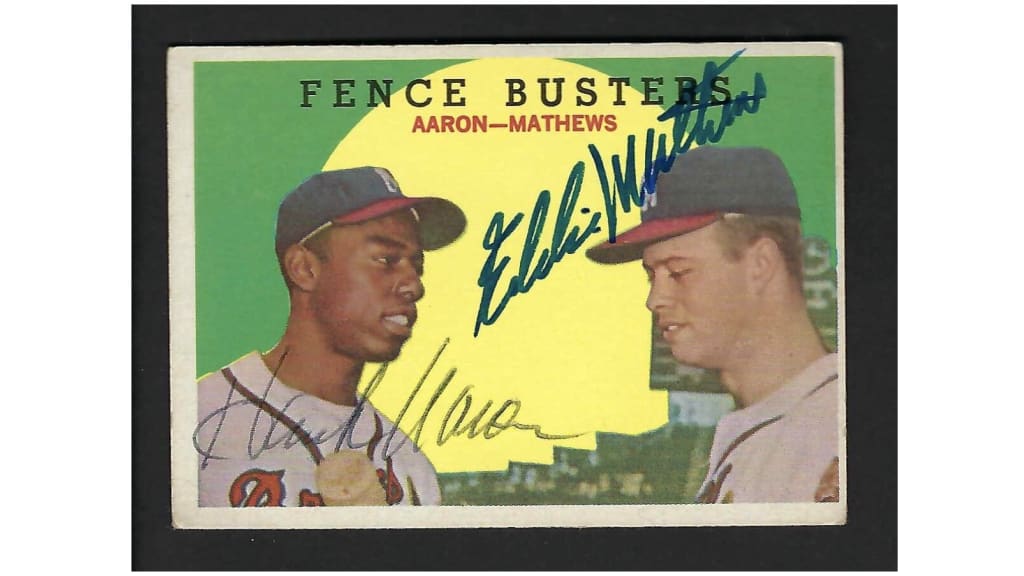
Hank Aaron and Eddie Mathews, 1959 Topps
This card depicting two Hall of Famers was submitted by multiple fans, including Erik Varon, Charlie Malone and Charlie Frenzel.
Varon even got his card signed by both Aaron and Mathews.
“In the mid-1980s I was in high school and regularly mailed retired baseball players seeking their autograph,” Varon wrote. “I mailed Hank Aaron and his teammate, Eddie Mathews. Both were kind enough to sign this card for me.”
“Fence Busters” is certainly an apt description for Aaron and Mathews, a duo that combined for more than 1,200 dingers. The two rank first and second in homers in Braves history.
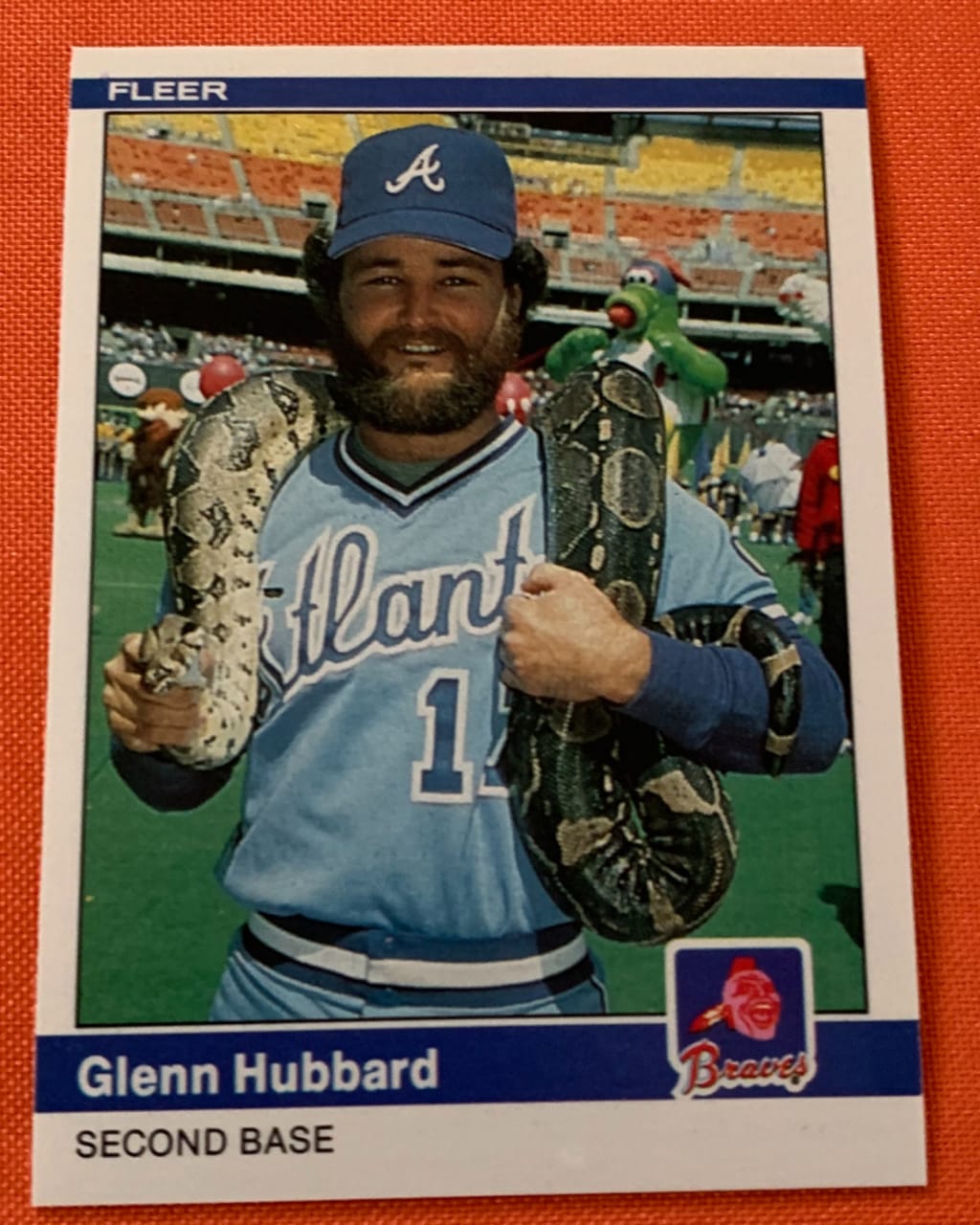
Glenn Hubbard, 1984 Fleer
The man is holding a giant snake. And he has a big smile on his face -- the man, not the snake.
Fleer went out-of-the-box in its 1984 set, and this is about as out-of-the-box as it gets -- having a Major League second baseman drape a snake around his shoulders.
As it turns out, Hubbard hated the card before warming up to it. We're glad his eyes were opened to its greatness.
Oh, and that he survived.
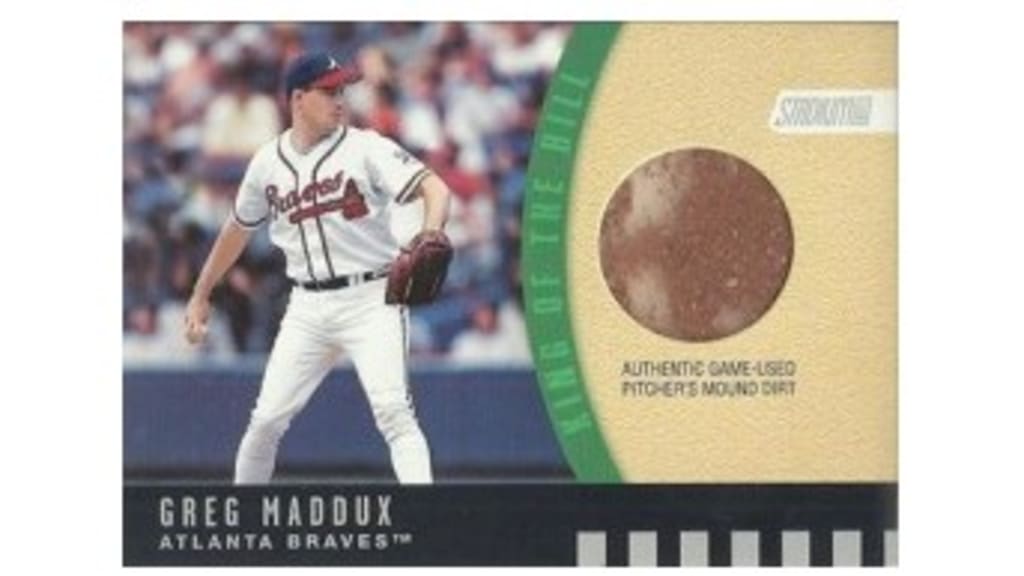
Greg Maddux, 2001 Topps Stadium Club
You've surely seen memorbilia cards with pieces of game-used jerseys, bases and bats. But game-used dirt?
Topps went there with the "King of the Hill" insert series in its 2001 Stadium Club set, claiming to use dirt from an actual pitcher's mound. -- Thomas Harrigan
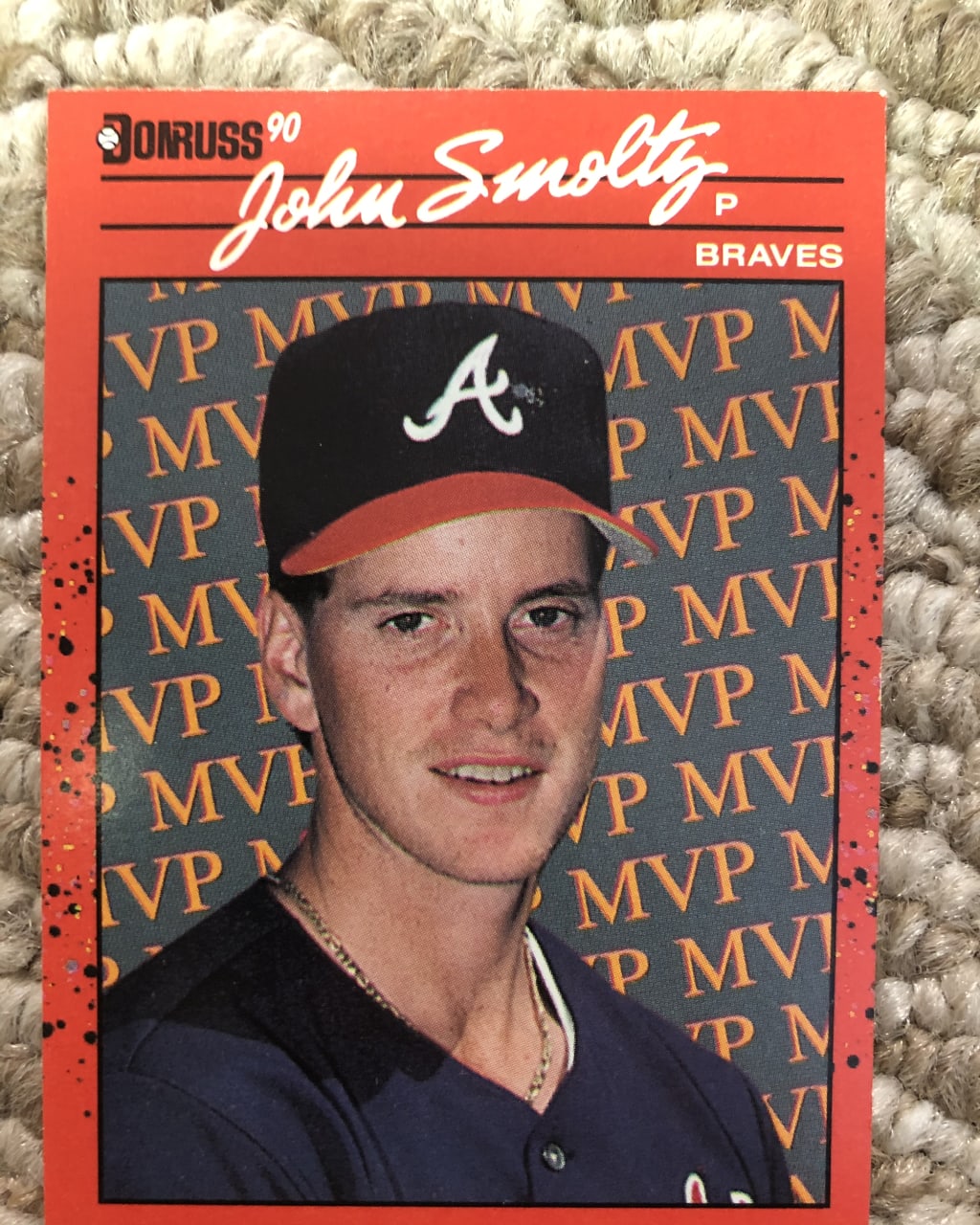
John Smoltz, 1990 Donruss
Smoltz had a terrific 1989 season to earn some MVP typography on his 1990 Donruss card, tossing over 200 innings of 2.94 ERA ball. He earned an All-Star nod in just his second season, foreshadowing the years to come. There’s only one problem, though. That’s not John Smoltz.
The picture on the card is actually his fellow Hall of Fame teammate Tom Glavine. The 1990 Donruss set was filled with errors that are a pleasure to look back on, including airbrushed photos, missing letters and a myriad of other anomalies.
Glavine, Smoltz and Greg Maddux made up one of the best rotations of all time in the ‘90s, leading Atlanta to five National League pennants and a World Series win in 1995. -- Nick Aguilera

Warren Spahn, 1956 Topps
We're throwing it back to the Milwaukee days for this one, and why not? Spahn is one of the greatest starting pitchers of all time, a legendary lefty who won 363 games and posted a 3.09 ERA over a 21-year MLB career. He was the 1957 NL Cy Young Award winner, a 17-time All-Star, won three ERA titles and was inducted into the Hall of Fame in 1973.
Thanks to Andrew C. of Lilburn, Georgia for submitting this card in our survey. It's a beauty -- with the action shot and headshot with the light standards of the stadium in the background, as well as a faux autograph, this one's about as classic as they come. -- Manny Randhawa
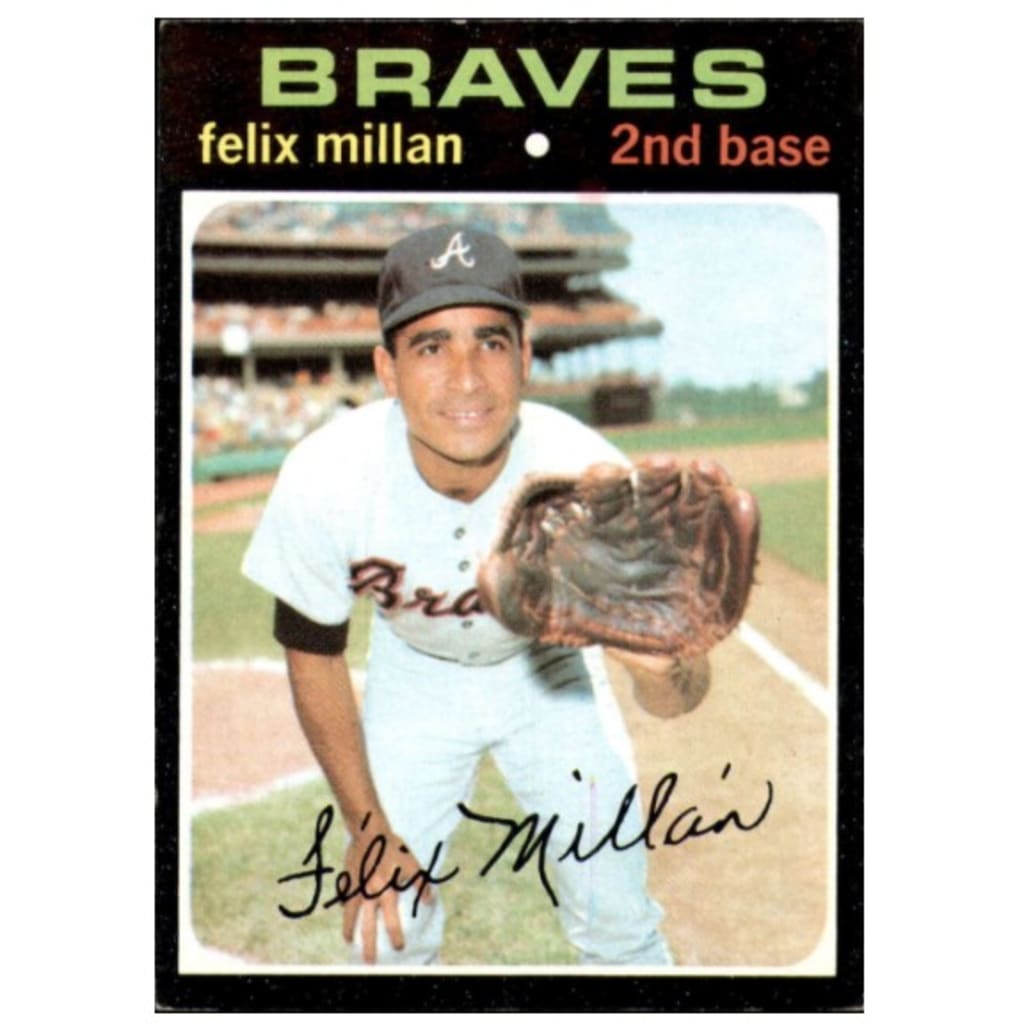
Felix Millan, 1971 Topps
Paul King of Rockaway, N.Y., is a Mets fan, but he submitted Millan’s 1971 Topps card in our survey.
“I liked Felix Millan's '71 card since I was a kid because of his glove,” King wrote. “It was cool that a pro had a glove that looked like he might have used it since high school. Fortunately, he got traded to the Mets two years later.”
Millan indeed joined the Mets after the 1972 season, although his best years came with Atlanta. In six seasons with the Braves, Millan made three All-Star teams and won two Gold Glove Awards, presumably while wearing the glove he had for this card photo. -- Thomas Harrigan
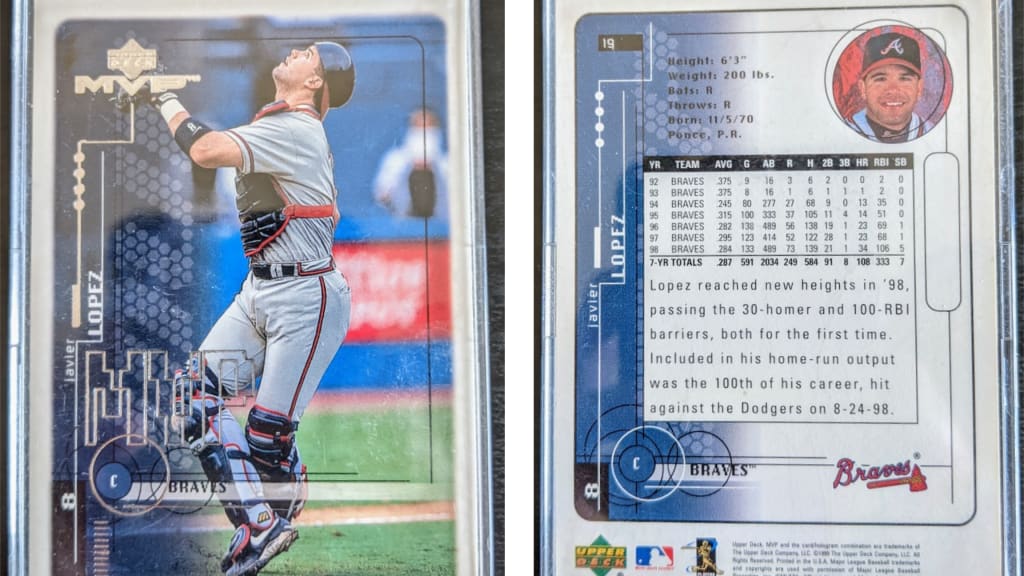
Javy Lopez, 1999 Upper Deck
When you have a favorite player, you want anything and everything with his likeness on it. That definitely includes baseball cards, and that was the case for David T. of Centerville, Utah, who submitted this Lopez card in our survey.
"Javy Lopez was and still is my favorite baseball player," David wrote. "I wanted his baseball card so badly. I spent all of my allowance on card packs. It was 1999 when it finally happened. I was sitting in the back seat of the family Buick. Opened the pack and finally saw Javy. I handled it gingerly and put it in a case as soon as I got home, where it remains to this day. As a kid I used to put on gloves to take it out of the case and handle it. It hasn't been touched by anyone since I opened the pack that day."
Now that's dedication to your baseball hero.
It's a good year for a Lopez card, too -- he was coming off a huge 1998 campaign, in which the catcher belted 34 homers and drove in 106 runs. -- Manny Randhawa
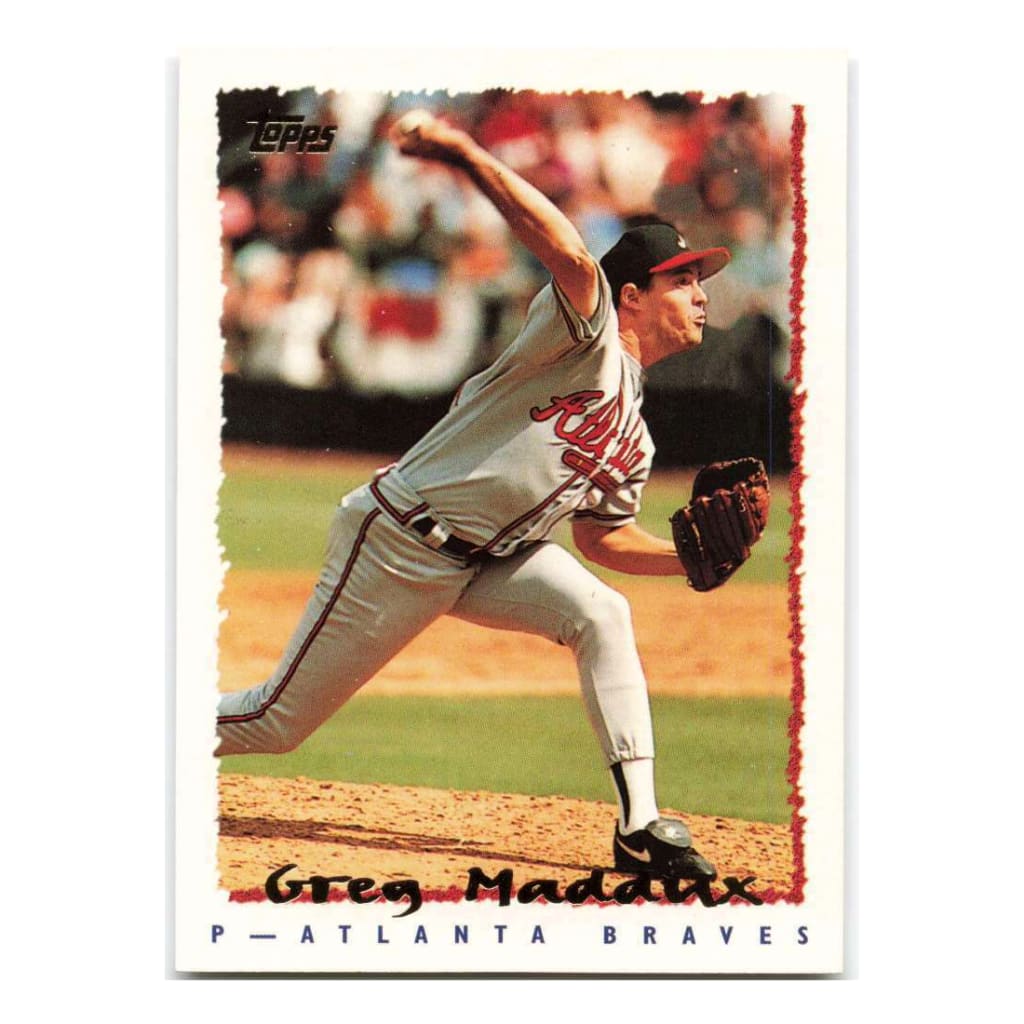
Greg Maddux, 1995 Topps
Maddux in 1995 … wow.
The Braves ace went 19-2 with a 1.63 ERA, won his fourth straight Cy Young Award and helped pitch Atlanta to a World Series championship.
Topps chose a nice picture for Maddux's 1995 card, too, capturing the right-hander just as his arm begins to whip forward mid-pitch, a look of concentration on his face.
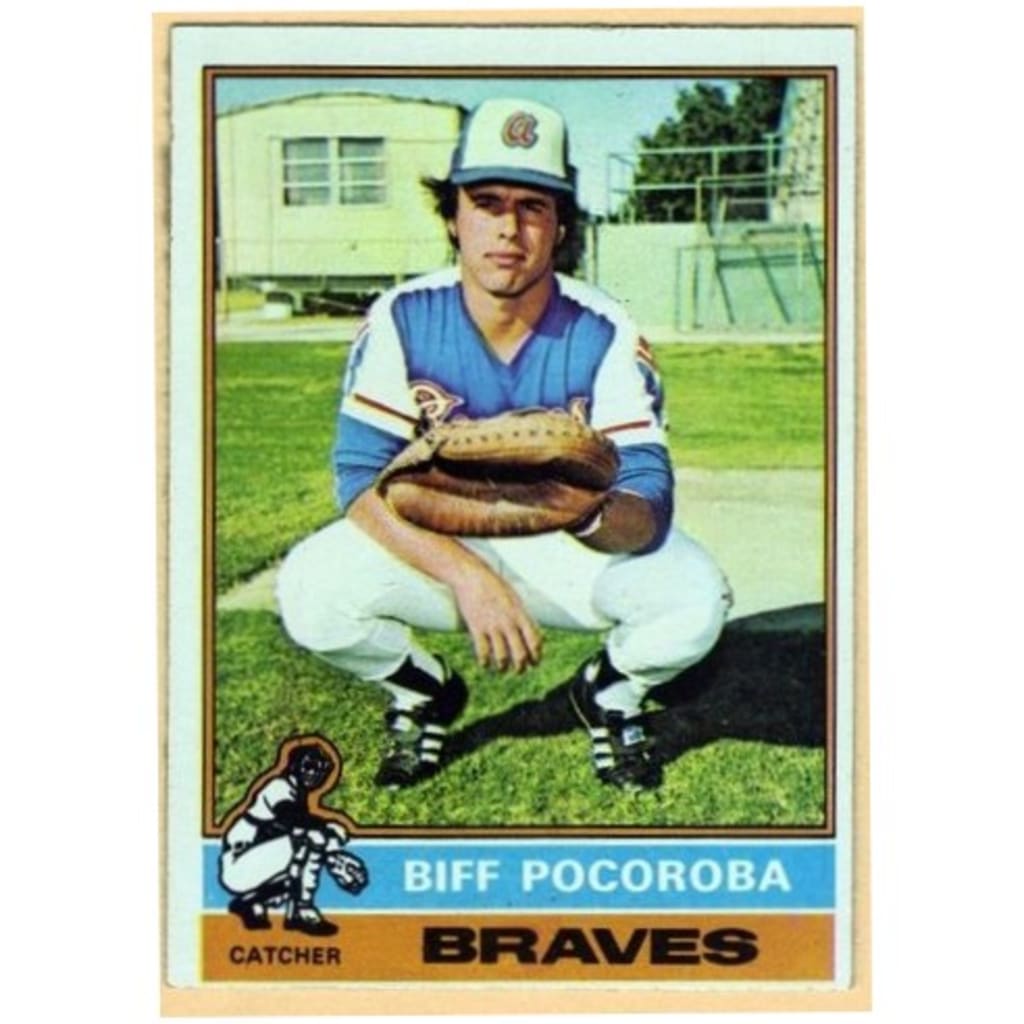
Biff Pocoroba, 1976 Topps
Although Pocoroba was a longtime backup catcher for the Braves and had an unremarkable Major League career, with a .256 average and 21 homers in 10 seasons, his ‘76 Topps rookie card garnered multiple mentions in our survey.
We’ll let Mike Holtzclaw of Chesapeake, Va., explain why the card holds a special significance for him.
“My friends and I collected cards, and we always loved the 1976 Topps Biff Pocoroba, just for its weirdness,” Holtzclaw wrote. “The trailer in the background. The fake grass. The hair sticking out from under his cap. The squint into the sun. We joked that he made the team at the last minute and the Topps photographer banged on his trailer door and woke him for the photo. He didn't have time to comb his hair -- just squat down for a picture. The sun's in your eyes? Don't worry. Pocoroba died last year, and we all texted pictures of that card to each other. Back in the days when a baseball card photo didn't have to be good to be good enough."
Seattle’s Ryan Mefferd, meanwhile, was drawn to the card mainly because of Pocoroba’s unusual first name. To date, he’s the last player named “Biff” to play in the Major Leagues.
“I am not sure when I got this one, or why it is so special,” Mefferd said. “I had just started collecting or was given a shoebox of cards at some point. The name Biff Pocoroba was another draw. I followed his career and was excited when he made an All-Star team, and saddened when he died. The card marks the beginning of a deep love for my favorite sport.” -- Thomas Harrigan


